Rock Climbing from Rifugio Duca d’Aosta
Rock Climbing at Rio Gere and Crepo Longo
Rock Climbing on the Tofane Massifs
Climbing and Riding Itineraries
Equipped Trails and Easy Via Ferrata Routes
Via Ferrata through the Lagazuoi Tunnel
Ra Pegna and Ra Bujela Via Ferrata Routes
Ra Gusela Via Ferrata Route on Mt Nuvolau
Via Ferrata Routes for Expert Climbers
Formenton Via Ferrata Route between Tofana Terza and Tofana di Mezzo
Adventurous rock climbers are spoilt for choice in Cortina, being able to pick their favourite adventure among via ferratas, rock walls, and outdoor climbing cliffs on the most spectacular rock faces of the Dolomites. In fact, the Queen of the Dolomites offers over 1000 routes, both classic and modern ones. Each route differs for sun exposure, rating, quality of rock, spires and spurs to please climbers of any ability. In addition, there are many cliffs equipped for free climbing.
The Climb&Ride formula combines the excitement of climbing a Dolomite peak along a via ferrata route and the fun of riding downhill along amazing trails on your mountain bike or e-bike.
Cortina Skiworld lift facilities are an invaluable aid whether you plan to easily approach the start of your itinerary or to return down to the valley after a tiring trekking.
The Queen of the Dolomites also features protected trails and over 30 via ferrata routes of different grading, laid out with fixed climbing aids such as wire cables, iron ladders, and aerial walkways. Climbing up these routes to reach the Dolomite summits, a Unesco World Heritage site, means both great physical exercise and immense joy for the eyes. In fact, these routes run along scenic lines up the rock faces from one peak to the next and often end up above 3000 m of altitude. Up there, spectacular views unfold on the surrounding mountainscape.
5 Torri: these wonderful iconic towers in the Ampezzo Dolomites combine fun, historical highlights, and all the elements that make them unique. In the summer, the area is served by two chairlifts: Cinque Torri and Fedare-Nuvolau.
Visitors will be intrigued and amazed by the unmistakable shape of the peaks of Dolomia Principale, as well as by the boulders left behind by the history of the great ice ages and by the amazing pasturelands. The area comprising 5 Torri, Mt Averau, and Giau is highly popular among rock climbers who can find here one of the most longed for outdoor climbing cliffs.
The 5 Torri rock faces feature over 200 protected pitches of different rating – ranging from 3 to 8b – and several classic and modern routes. Since not all the classic routes are protected with pitons, wearing adequate climbing gear is strongly recommended.
A few hints about these towers: Torre Grande is the main and southernmost tower. The top splits into three summits: the west, the north, and the south summits. The south tower is the most popular with climbers being the richest in routes, among which Myriam is the most beautiful and famous one. The second tower also splits into three different summits: Torre Lusy, Torre del Barancio and Torre Romana. Most of the classic routes are found on the north face. The third tower is known as Torre Latina, again splitting into two summits. The fourth tower splits in Quarta Alta and Quarta Bassa, next to them stands Torre di Mezzo. Lastly, Torre Inglese, the smallest and northernmost tower, ends with two spires.
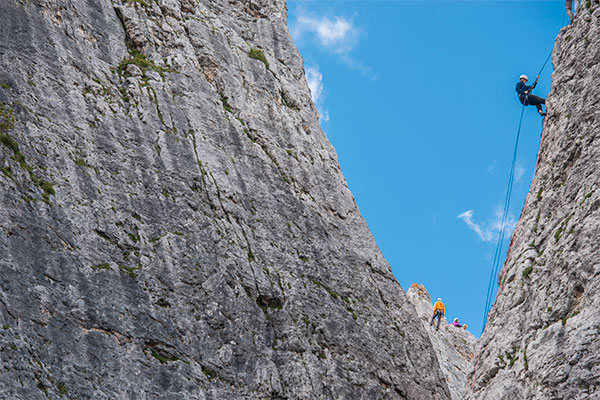
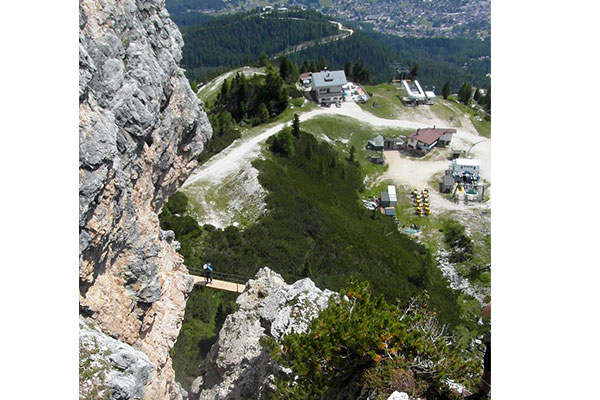
Close to Rifugio Duca d’Aosta, in the Tofane area, there is a wonderful cliff that offers spectacular views over the Ampezzo valley. The foot of the cliff can be easily reached by chairlift from Pié Tofana. From Rifugio Duca d’Aosta, take the trail below the mountain guesthouse to the north and head towards the well obvious cliff across the slopes that are winter ski runs.
The cliff, at 2100 m, features 20 metre-long pitches of intermediate rating on the vertical face of solid grey rock. The second part is rather overhanging and more technical and it features longer pitches of 40 metres or more.
Most of the pitches are well protected and well bolted and their rating ranges between 6a and 7c+.
Mt Lagazuoi features a number of climbing cliffs, among them are Piccolo Lagazuoi and Sass de Stria. Both sites are rich in historical significance. In fact, during the First World World, between 1915 and 1917, these areas were the theatre of fierce fighting between the Italian and the Austrian-Hungarian armies. The approaching trails start from the parking area of the Lagazuoi cable car. A 20-30 minute walk uphill, along trail 402, leads to the base of the first cliff, leaving the trail at the intersection signposted with “climbing cliff” directions. The base of the second cliff is only a few minutes away from the parking area, heading towards Passo Valparola. Just before the First World War Museum, take a downhill path leading to the cliff, well obvious from the road.
The Piccolo Lagazuoi cliff is well protected since it was first meant for beginners, while, in a second time, it was also designed for expert climbers. It features about 40 pitches, ranging between 15 and 30 metres of length, rated from 4a to 7b. The amazing views span all around as far as the horizon surrounded by the most famous Dolomite peaks: Sorapis, 5 Torri, Croda da Lago, Averau, Nuvolau, Col Gallina, Marmolada, and Sass de Stria.
Sass de Stria is a minor peak of the Fanis Group in the Passo Falzarego area. It was first created for beginners, thanks to the rocky layer skirting the first part of the trail, which ascends the southern spur with moderately vertical plates. It features about 30 pitches ranging between 12 and 25 metres of length and 4a to 6a rating.
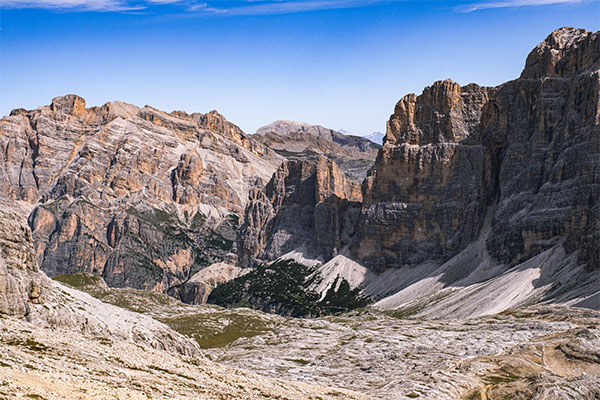
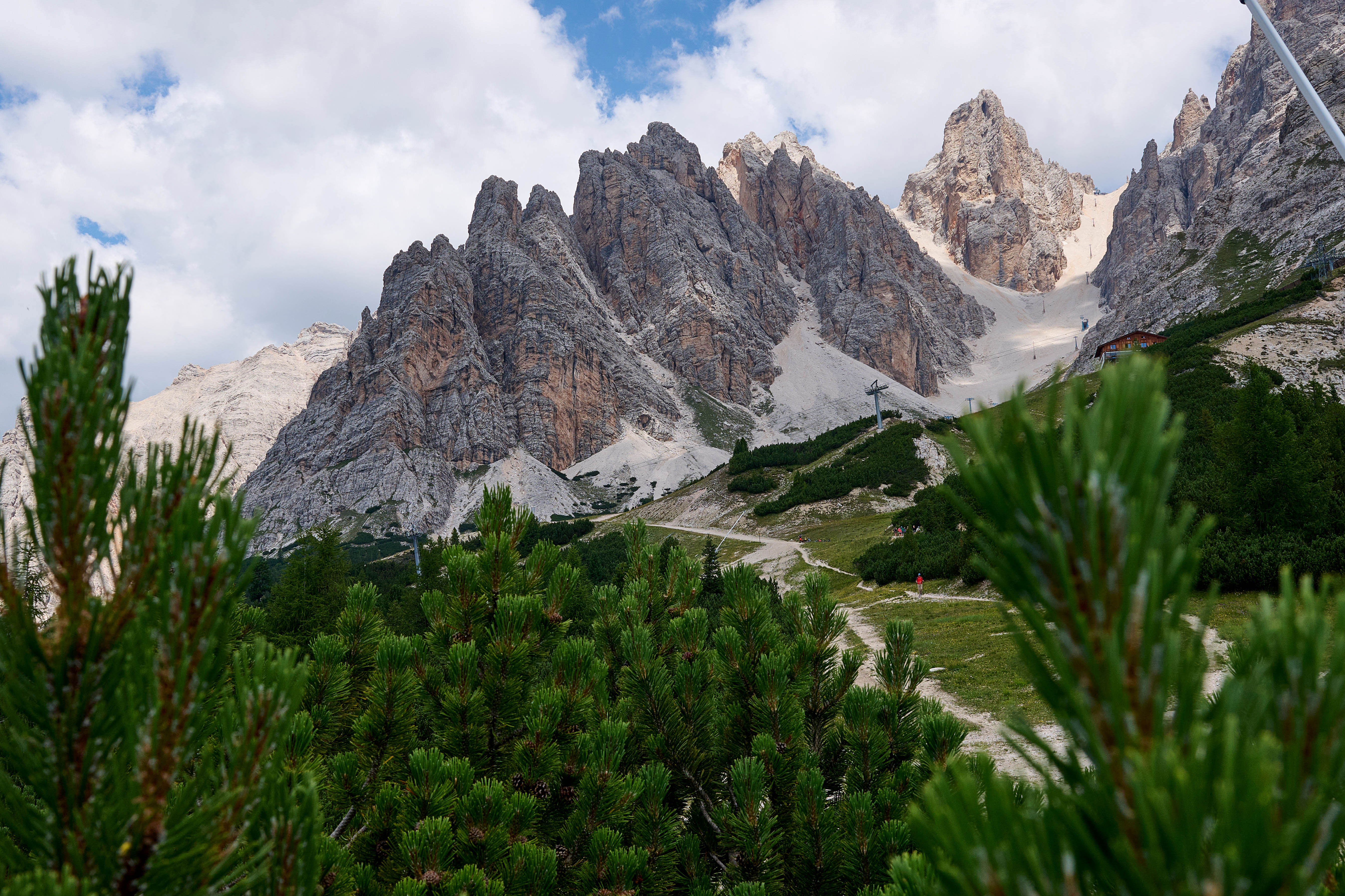
The Rio Gere cliff is located at 1680 m of altitude, close to the namesake locality. Climbers can park in the Rio Gere parking areas and then walk along trail 206 heading to Mandres. After crossing the torrent, ascend the steep slope for about 15 minutes to reach the cliff which is well obvious from the road. The experience will be enhanced by the wonderful views of Mt Cristallo.
The climbing cliff features about two dozen, up to 40 metre-long pitches, running on Dolomia solid rock with hand holes and notches. Most of the pitches are rated as 7th grade, therefore, adequate fitness, strength, and expert climbing skills are strongly recommended to attempt these lines.
The Crepo Longo rocky ridge has been recently equipped with 26 pitches developing on solid rock. Difficulty levels are mainly 6a/6b, however it also features a few 5c pitches, two 4 grade pitches and currently only one 6c pitch.
The Faloria cable car, whose station is in Cortina’s centre, is undoubtedly the most convenient means to reach the cliff. From the top station, walk downhill heading north-east across the ski run. Just before the valley station of the chairlift riding to Tondi di Faloria, take a 20 minute-long, well signposted trail leading to the climbing cliff. Alternatively, climbers may drive to Rio Gere (Cristallo and Faloria chairlifts valley stations) along the road from Cortina to Passo Tre Croci. Park the car and start walking up the dirt road winding up the ski slopes of the Faloria ski area up to the valley station of the chairlift to Tifugio Tondi. The climbing cliff is nearby.
Some of the most beautiful climbing routes of the Dolomites run up the rock faces of Tofana di Rozes and Tofana di Mezzo. All the itineraries leading to Tofana di Rozes start from Rifugio Dibona that can be conveniently reached from Cortina by driving along the road to Passo Falzarego. Whereas, the Freccia nel Cielo cable car is the most convenient means to reach Tofana di Mezzo and then approach the foot of the rockface walking across the scree.
The Costantini-Apollonio route is one of the most famous ones on Tofana di Rozes. This beautiful climb runs up a perfect line, yet, excellent training and continuous efforts are required due to its development. The first stretch of the ascent is through a crack in the grey rock basement up to a first ledge, from where climbers can rappel down in the canyon between the Pilastro (the buttress) and Primo Spigolo (the first spur). Above, instead, there are the two difficult roofs and the “humpback” move which represent the key problems along the line. In the final stretch, the line traverses to the left and ends up on the summit ridge together with the Costantini-Ghedina route.
The Costantini-Ghedina spur is an intermediate route (rated 4 and 5 and featuring only one 6 move) on the left spur of the Tofana di Rozes Pilastro (buttress).The most demanding stretch of the ascent are the pitches halfway up traversing the two large yellow roofs.
Eötvös Dimai is a classic route developing up the middle line of the difficult Tofana southern face. This line is considered as one of the most beautiful ones on the rock face for its grandiose environment. Though it is moderately difficult, climbers are recommended to attempt the route only with great expertise and excellent training.
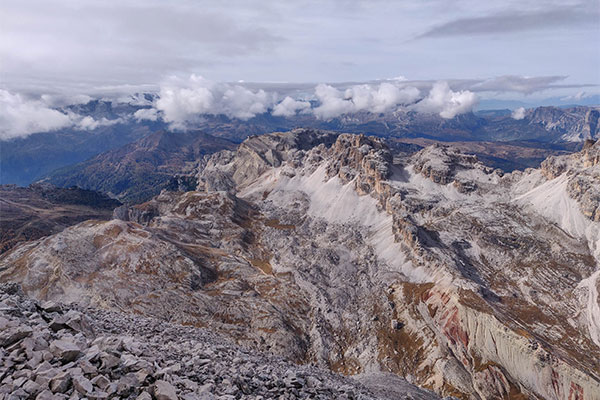
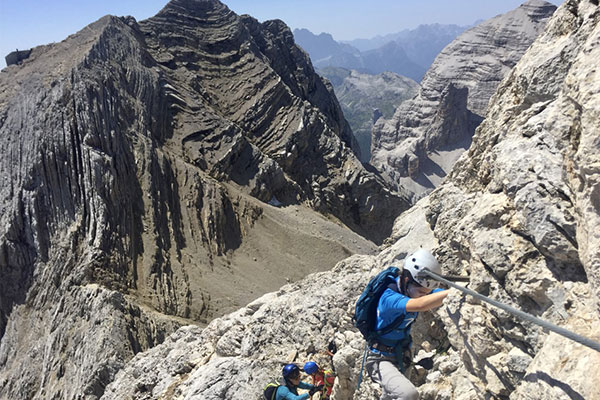
Primo Spigolo (first spur) is a highly popular intermediate route. The first stretch ascends the large dihedral at the base of the spur, then it follows its line and traverses to the right to avoid the overhanging roofs. From the wide ledge, the line continues to the left of the spur, first, and then to the right up to the final chimney.
Sognando l’Aurora (dreaming about sunrise) is a charming route opened in 2006. Its superb line, featuring highly demanding pitches, runs up Pilastro di Rozes southern face, one of the legendary walls of the Dolomites, and ends up on the summit of the big wall. The rock is solid all along the whole 600-m route, and the yellow-reddish rock between the two ledges is superb.
Via degli Scoiattoli (the Squirrels’ route) up Tofana di Mezzo is a classic route running up the central part of Tofana di Mezzo eastern face. Except for a few stretches, the rock is solid and the route is well bolted thus ensuring safe climbing. The route was originally done on aid, but is today repeated free climbing with up to 7a rating.
Via Falcone and Borsellino is another amazing, though demanding, route on Tofana di Mezzo. The rock is solid and the line is protected with in-rings and rappel anchors. The line develops to the left of Via degli Scoiattoli.
Can you fancy anything more exciting and thrilling than rock climbing and riding your bike in a single adventure? The Climbing and Riding formula combines the thrill of climbing a Dolomite summit up a via ferrata route with the fun of riding downhill along spectacular trails on your mountain bike or e-bike. Should you wish to enjoy this experience in total safety, we recommend hiring an instructor by contacting Cortina Alpine Guides or Cortina 360 Guides.
One of the most exciting multiple-day itineraries starts from the Natural Park of the Ampezzo Dolomites. The via ferrata of the Fanes Waterfalls, immersed in a wonderful natural environment, is the first leg of this route. Once you have completed the via ferrata, get on your bike and pedal to Rifugio Dibona at the foot of majestic Tofana di Rozes, one of Cortina’s iconic massifs. Overnight stay is in the mountain guesthouse. The following morning, pedal up to Rifugio Duca d’Aosta and get ready to climb two amazing via ferrata routes: Ra Bujéla (intermediate difficulty) and Ra Pegna (easy). The routes side the legendary Schuss, the steepest stretch of the ski run where the Women’s World Cup races are held every winter.
Climb back on the saddle and ride as far as Rifugio Scoiattoli. Alternatively, you may take the bike-friendly chairlift to 5 Torri: the worldwide famous outdoor climbing cliffs. Spend the night in the mountain guesthouse and the next morning approach on foot the two scenic via ferrata routes to summit Mt Nuvolau and Mt Averau, respectively. From the top, take some time to enjoy the breathtaking views of Mt Civetta and Mt Marmolada.
Return to Rifugio Scoiattoli and get on your bike to traverse the valley heading to Rifugio Croda Da Lago G. Palmieri nestled on the shores of Lake Federa. Spend the night in this enchanted spot, a gem embedded in the mountains. The following morning, get on your bike and ride to Béco de Mezodì. Climb to the top along an easy 3rd grade route and then return to Cortina.
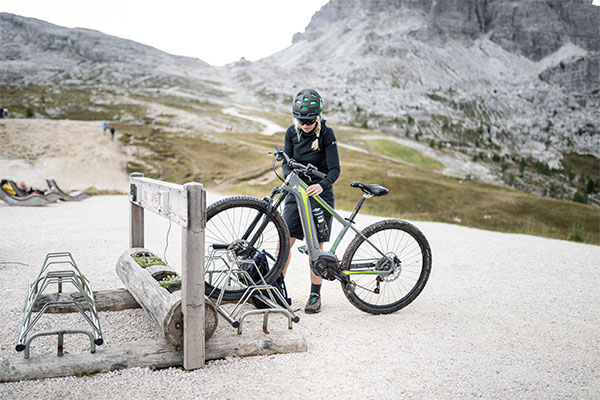
Cortina offers protected trails and over 30 via ferrata routes of different grading, laid out with fixed climbing aids such as wire cables, iron ladders, and aerial walkways. Climbing up these routes to reach the Dolomite summits, a Unesco World Heritage site, means both healthy physical exercise and immense joy for the eyes. In fact, these routes run along scenic lines up the rock faces from one peak to the next and often end up above 3000 m of altitude. Up there, spectacular views open up onto the surrounding awe-inspiring mountainscape.
Cortina Skiworld lift facilities are an invaluable aid whether you plan to easily approach the start of your itinerary or to return down to the valley after a tiring trekking.
The via ferrata route through the Lagazuoi tunnel retraces the sites of World War 1 which was fought on the Dolomite mountains. The Lagazuoi cable car conveniently takes visitors to the start of the route. Alternatively, hikers may walk up trail 402 from Passo Falzarego to Forcella Travenanes and, at the saddle, take trail 401 to reach the cable car mountain station. The hike takes about two hours. A further option is climbing up the Kaisejager protected trail on the other side of Mt Lagazuoi. If you wish to visit more war itineraries and the Austrian-Hungarian emplacements, we recommend climbing Via Ferrata Sottotenente Fusetti on Sass de Stria.
On the top of Mt Lagazuoi, where the namesake mountain guesthouse is nestled, follow the directions for the start of the trail leading to the tunnels, laid out with wire cables for support. Via ferrata kit, torch or headlamp, gloves, and helmet are strongly recommended (the gear may be rented on spot). A short way before the end of the itinerary, hikers can make a small detour to visit the Martini Ledge of great historical significance, then join trail 402 to Passo Falzarego and return to the starting point along the same way of the ascent.
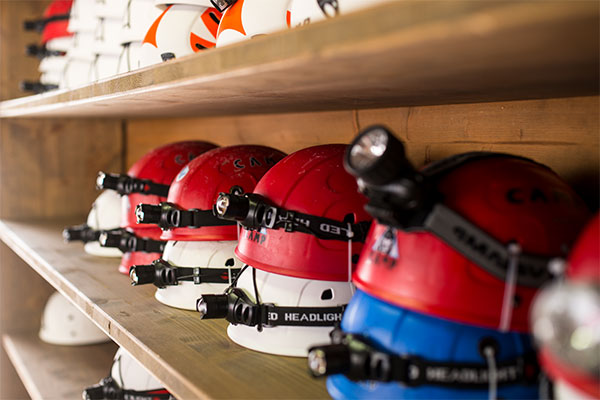
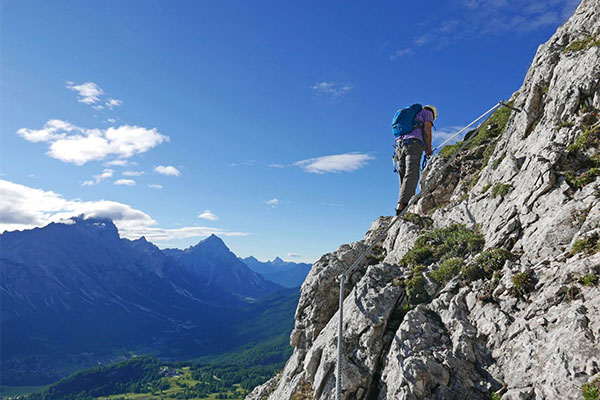
Ra Pegna is a simple, short, and easily accessible via ferrata route, but it is highly scenic and particularly interesting. It was recently designed by Cortina’s Alpine Guides to enrich and complement the offer of summer excursions and outdoor activities in the Tofane area. This easy route is suitable for the whole family, it can be combined with Ra Bujela via ferrata and can be included in a wonderful round trip starting from Rifugio Duca d’Aosta.
Ra Pegna, as well as the nearby Ra Bujela are great alternatives in case of unstable weather conditions, when attempting the longer and more demanding routes of the area may be dangerous. The area features plenty of routes: Via Ferrata Olivieri on Punta Anna, the via ferrata to Tofana di Mezzo and the Olivieri trail, equipped with wire cables for support.
The start of the Ra Bujela route can be easily and conveniently reached by chairlift from Pié Tofana. The route is equipped with two board-walks, 7 and 3 metre long, respectively, and runs up the Pomedes tower, known as “Ra Bujela”. It develops for 150 metres up the rocky face and for 100 metres along the summit ridge, with 100 metre elevation gain. The estimated time required is about 1 hour and a half.
The Astaldi itinerary, at the foot of Mt Tofana, is an excellent training gym for those attempting equipped trails for the first time and is also suitable for families. The route does not feature difficult moves, but its exposure and aerial stretches require great attention. The trail connects Rifugio Dibona to Pomedes and is often combined with other excursions, namely: Via Ferrata Olivieri on Punta Anna and Via Ferrata Tofana di Mezzo. The trail may be trodden both ways , i.e. from Pomedes to Rifugio Dibona as well. The path is mainly level, with few, gentle ups and downs and is particularly intriguing for the peculiarity of its colourful rock layers ranging from red to black and from green to reddish brown.
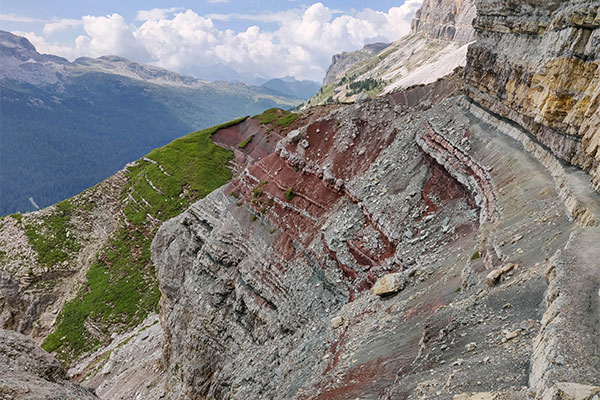
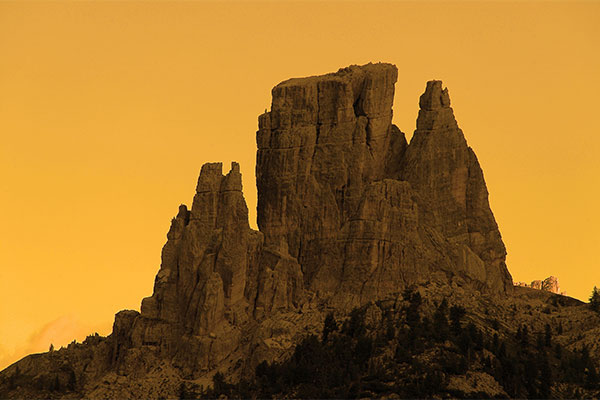
This legendary itinerary is the first of its kind in the Cortina area since it was built as early as 1883. It is suitable for families and beginners and leads to Rifugio Nuvolau, one of the most scenic vantage spots to enjoy spectacular views of the Dolomites all around. The route starts from and ends at Passo Giau and develops along an easy line, with some moderate exposure only in some stretches. From Passo Giau, take trail 452 and then 443 heading to 5 Torri, and lastly trail 438 leading to the saddle at the start of the via ferrata.
The initial stretch features a wide ledge without any difficult moves. Climbing up, the ledge becomes narrower and runs up a steep gully. A few more moves and you reach a plateau with Rifugio Nuvolau in the distance. Follow the trail, reach the opposite slope and climb up. From the top, the unobstructed view on the massifs all around is spectacular: 5 Torri, the Tofane, Croda da Lago and Marmolada loom in the horizon.
The return route is along trail 439 to Rifugio Averau and trail 464 to Rifugio Fedare. At the first junction, take trail 452 down to Passo Giau.
Via ferrata routes are protected trails laid out with holds, steps, ladders, and aerial walkways to enable inexperienced climbers to climb up rocks and bricks. These highly difficult routes feature serious exposure and require adequate training and physical fitness, besides an in-depth knowledge of the area. However, once you make sure you do have all these prerequisites, the ascent will be one of the most exciting experiences you have ever had.
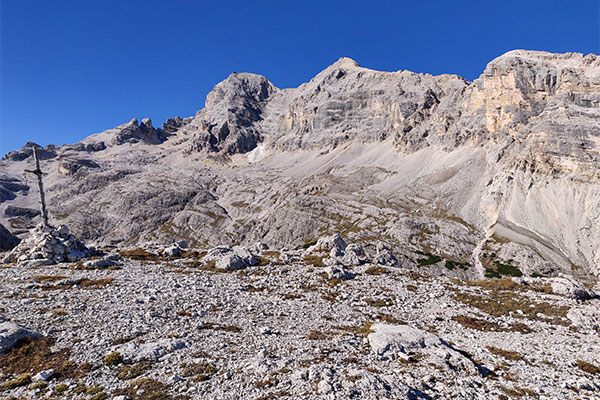
The spectacular itinerary connects Tofana Terza to Tofana di Mezzo. It can be attempted both downhill from Cima Tofana - i.e. climbing Tofana di Mezzo first - or downhill, starting from Ra Valles. Cima Tofana and Ra Valles are the second and third stations of the Freccia nel Cielo cable car. The itinerary requires fairly good mountain experience and much attention is to be paid when descending from Cima Tofana along the northern ridge. The uphill route is generally recommended because of the scree and talus that make footing unstable and difficult in the descent. This high-altitude route must be only attempted with the best weather conditions.
This highly technical route features several vertical stretches which, though laid out with steps and ladders, require excellent training and good mountaineering experience. The start is 40 minutes away from the Faloria cable car intermediate station.
From Cortina centre, take the Faloria cable car to Mandres, the intermediate station, at 1480 m. Alternatively, Mandres can be reached through a 40-minute walk, the path runs up the hill just below the lift cables and across meadows. From Mandres, take trail 206, gently climbing uphill towards the foot of Mt Faloria, then follow the directions for Ferrata Sci Club 18 as far as the intersection with a well marked approach trail leading to the start. The via ferrata route offers startling, sweeping views over the Ampezzo valley. The line develops all the way up the Crepe the Faloria rockface and features several difficult moves, spurs, and overhanging stretches. Therefore, only expert climbers are advised to attempt this route.
The Rio Gere - Son Forca chairlift in the Faloria area, helps save energy and time to approach the start of Marino Bianchi and Ivano Dibona via ferrata routes on Mt Cristallo. The latter is a rather long route which develops along the ridge and retraces the First World War sites.
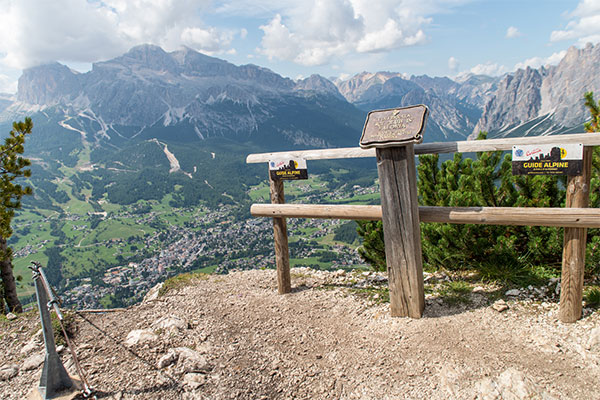

The Tomaselli via ferrata is one of the most technically demanding routes around Cortina as well as one of the most scenic ones and of great historical significance. Cima Fanis Sud is a spectacular peak rising in the Fanis-Lagazuoi group, side by side the majestic Tofane massifs. This technically difficult route features exposed portions and therefore requires excellent training and experience. However, once on top, the expansive view is awe-inspiring: the most amazing mountainscape of the Dolomites unfolds before your eyes sweeping from the Tofane to Pale di San Martino as far as Mt Civetta.
To reach the start of the route, take the Lagazuoi cable car and follow trail 401 as far as the saddle. Then take trail 20 where a few remnants of the First World War are found. A 2-hour walk takes hikers to the start of the via ferrata. The first moves are along a crack and then continue up sheer vertical walls, thus making even the start highly demanding. Wall after wall you climb to the summit ridge at 2980, but the effort is well repaid by the amazing view. The descent is down the north face equipped with a wire cable all along the way down. Finally, you may either reach Rifugio Lagazuoi or walk down to Passo Falzarego.